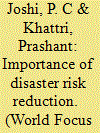| Srl | Item |
| 1 |
ID:
132485


|
|
|
|
|
| Publication |
2014.
|
| Summary/Abstract |
Disasters are occurring globally. Developed as well as developing countries, are being affected by the catastrophic consequences of both natural and human- made disasters. According to the CRED', in 2013 alone the total number of natural disasters amount to around 334 events worldwide causing 22,616 deaths and around 97 million "affected people. The economic damages due to disasters was to the tune of 118 billion US $ last year. 2013 was also a very harsh year for Asia as'88 percent of the mortalities were reported from this continent which was far more than the decadal (2003-2012) average of 62 percent. India, in particular" ranked second in the world with 7,368 deaths; third with 16.7 million people affected due to disasters and ranked eighth with an economic _loss of 2.4 billion US S. Besides these ?gures there are disasters that. have, made international news recently for example the 2011 Japanese Tsunami and the consequent nuclear emergency in the Fukushima Nuclear Plant. In the Indian context we are still living with the vivid memories of disasters like the Bhopal Gas Tragedy, Gujarat" Earthquake, Orissa Super Cyclone, Indian Ocean Tsunami, Kashmir Earthquake, Kosi Floods and Cyclone Aila. India is also prone to several other kinds of disasters and a large land mass is vulnerable to natural hazards.
|
|
|
|
|
|
|
|
|
|
|
|
|
|
|
|
| 2 |
ID:
124955


|
|
|
|
|
| Publication |
2013.
|
| Summary/Abstract |
In 2008, survivors of the 1984 Bhopal Gas Disaster in India undertook a 500-mile march to New Delhi, protesting a long history of governmental neglect of the survivors of the event. This is one episode of a 25-year-old organized international campaign that continues in the present. This article examines the ways in which three bodily substances - blood, hearts and ketones - were produced and circulated through the 2008 protests. Placed within a broader history of substance-politics in the region, this article suggests that these protests produced an imagination of bodily substances that surfaced messy contradictions that became difficult for the Indian State to disregard. This article also shows how these protests distanced themselves from the cynicism attached to similar modes of corporeal activism in the contemporary Indian landscape. In sum, this article traces the production of an activist corporeal counter-discourse that, for at least a time, contaminated the procedures through which the Indian State disregards the health of its marginal citizens.
|
|
|
|
|
|
|
|
|
|
|
|
|
|
|
|